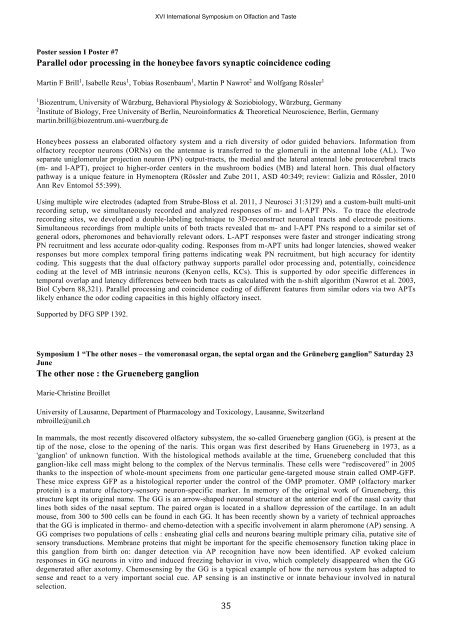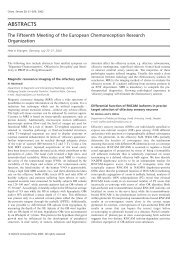XVI International Symposium on Olfaction and Taste - ecro
XVI International Symposium on Olfaction and Taste - ecro
XVI International Symposium on Olfaction and Taste - ecro
You also want an ePaper? Increase the reach of your titles
YUMPU automatically turns print PDFs into web optimized ePapers that Google loves.
<str<strong>on</strong>g>XVI</str<strong>on</strong>g> <str<strong>on</strong>g>Internati<strong>on</strong>al</str<strong>on</strong>g> <str<strong>on</strong>g>Symposium</str<strong>on</strong>g> <strong>on</strong> Olfacti<strong>on</strong> <strong>and</strong> <strong>Taste</strong><br />
Poster sessi<strong>on</strong> I Poster #7<br />
Parallel odor processing in the h<strong>on</strong>eybee favors synaptic coincidence coding<br />
Martin F Brill 1 , Isabelle Reus 1 , Tobias Rosenbaum 1 , Martin P Nawrot 2 <strong>and</strong> Wolfgang Rössler 1<br />
1 Biozentrum, University of Würzburg, Behavioral Physiology & Soziobiology, Würzburg, Germany<br />
2 Institute of Biology, Free University of Berlin, Neuroinformatics & Theoretical Neuroscience, Berlin, Germany<br />
martin.brill@biozentrum.uni-wuerzburg.de<br />
H<strong>on</strong>eybees possess an elaborated olfactory system <strong>and</strong> a rich diversity of odor guided behaviors. Informati<strong>on</strong> from<br />
olfactory receptor neur<strong>on</strong>s (ORNs) <strong>on</strong> the antennae is transferred to the glomeruli in the antennal lobe (AL). Two<br />
separate uniglomerular projecti<strong>on</strong> neur<strong>on</strong> (PN) output-tracts, the medial <strong>and</strong> the lateral antennal lobe protocerebral tracts<br />
(m- <strong>and</strong> l-APT), project to higher-order centers in the mushroom bodies (MB) <strong>and</strong> lateral horn. This dual olfactory<br />
pathway is a unique feature in Hymenoptera (Rössler <strong>and</strong> Zube 2011, ASD 40:349; review: Galizia <strong>and</strong> Rössler, 2010<br />
Ann Rev Entomol 55:399).<br />
Using multiple wire electrodes (adapted from Strube-Bloss et al. 2011, J Neurosci 31:3129) <strong>and</strong> a custom-built multi-unit<br />
recording setup, we simultaneously recorded <strong>and</strong> analyzed resp<strong>on</strong>ses of m- <strong>and</strong> l-APT PNs. To trace the electrode<br />
recording sites, we developed a double-labeling technique to 3D-rec<strong>on</strong>struct neur<strong>on</strong>al tracts <strong>and</strong> electrode positi<strong>on</strong>s.<br />
Simultaneous recordings from multiple units of both tracts revealed that m- <strong>and</strong> l-APT PNs resp<strong>on</strong>d to a similar set of<br />
general odors, pherom<strong>on</strong>es <strong>and</strong> behaviorally relevant odors. L-APT resp<strong>on</strong>ses were faster <strong>and</strong> str<strong>on</strong>ger indicating str<strong>on</strong>g<br />
PN recruitment <strong>and</strong> less accurate odor-quality coding. Resp<strong>on</strong>ses from m-APT units had l<strong>on</strong>ger latencies, showed weaker<br />
resp<strong>on</strong>ses but more complex temporal firing patterns indicating weak PN recruitment, but high accuracy for identity<br />
coding. This suggests that the dual olfactory pathway supports parallel odor processing <strong>and</strong>, potentially, coincidence<br />
coding at the level of MB intrinsic neur<strong>on</strong>s (Keny<strong>on</strong> cells, KCs). This is supported by odor specific differences in<br />
temporal overlap <strong>and</strong> latency differences between both tracts as calculated with the n-shift algorithm (Nawrot et al. 2003,<br />
Biol Cybern 88,321). Parallel processing <strong>and</strong> coincidence coding of different features from similar odors via two APTs<br />
likely enhance the odor coding capacities in this highly olfactory insect.<br />
Supported by DFG SPP 1392.<br />
<str<strong>on</strong>g>Symposium</str<strong>on</strong>g> 1 “The other noses – the vomer<strong>on</strong>asal organ, the septal organ <strong>and</strong> the Grüneberg gangli<strong>on</strong>” Saturday 23<br />
June<br />
The other nose : the Grueneberg gangli<strong>on</strong><br />
Marie-Christine Broillet<br />
University of Lausanne, Department of Pharmacology <strong>and</strong> Toxicology, Lausanne, Switzerl<strong>and</strong><br />
mbroille@unil.ch<br />
In mammals, the most recently discovered olfactory subsystem, the so-called Grueneberg gangli<strong>on</strong> (GG), is present at the<br />
tip of the nose, close to the opening of the naris. This organ was first described by Hans Grueneberg in 1973, as a<br />
'gangli<strong>on</strong>' of unknown functi<strong>on</strong>. With the histological methods available at the time, Grueneberg c<strong>on</strong>cluded that this<br />
gangli<strong>on</strong>-like cell mass might bel<strong>on</strong>g to the complex of the Nervus terminalis. These cells were “rediscovered” in 2005<br />
thanks to the inspecti<strong>on</strong> of whole-mount specimens from <strong>on</strong>e particular gene-targeted mouse strain called OMP-GFP.<br />
These mice express GFP as a histological reporter under the c<strong>on</strong>trol of the OMP promoter. OMP (olfactory marker<br />
protein) is a mature olfactory-sensory neur<strong>on</strong>-specific marker. In memory of the original work of Grueneberg, this<br />
structure kept its original name. The GG is an arrow-shaped neur<strong>on</strong>al structure at the anterior end of the nasal cavity that<br />
lines both sides of the nasal septum. The paired organ is located in a shallow depressi<strong>on</strong> of the cartilage. In an adult<br />
mouse, from 300 to 500 cells can be found in each GG. It has been recently shown by a variety of technical approaches<br />
that the GG is implicated in thermo- <strong>and</strong> chemo-detecti<strong>on</strong> with a specific involvement in alarm pherom<strong>on</strong>e (AP) sensing. A<br />
GG comprises two populati<strong>on</strong>s of cells : ensheating glial cells <strong>and</strong> neur<strong>on</strong>s bearing multiple primary cilia, putative site of<br />
sensory transducti<strong>on</strong>s. Membrane proteins that might be important for the specific chemosensory functi<strong>on</strong> taking place in<br />
this gangli<strong>on</strong> from birth <strong>on</strong>: danger detecti<strong>on</strong> via AP recogniti<strong>on</strong> have now been identified. AP evoked calcium<br />
resp<strong>on</strong>ses in GG neur<strong>on</strong>s in vitro <strong>and</strong> induced freezing behavior in vivo, which completely disappeared when the GG<br />
degenerated after axotomy. Chemosensing by the GG is a typical example of how the nervous system has adapted to<br />
sense <strong>and</strong> react to a very important social cue. AP sensing is an instinctive or innate behaviour involved in natural<br />
selecti<strong>on</strong>.<br />
35



